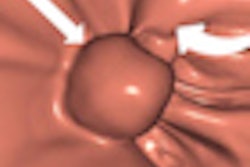
NEW YORK (Reuters Health) - When patients make sequential position changes during colonoscopy examinations, the improvement in luminal distension leads to detection of more adenomas and polyps, a U.K. team has shown.
"Dynamic patient position changes are potentially a cost-neutral way to help improve adenoma detection rates and hence colonoscopic quality," said Dr. James E. East in an e-mail.
Dr. East and colleagues at St. Mark's Hospital and Imperial College London report their finding in the October 18 online issue of Gastrointestinal Endoscopy.
They explain that good visualization during colonoscope withdrawal lowers the miss rate of adenomas. The use of position changes facilitates adequate colonic distension, based on having the region being examined at the highest point, to allow gas to rise and fill the area.
"Therefore," the authors elaborate, "the hepatic flexure is best examined with the patient in the left lateral position; the transverse colon, which lies relatively anteriorly in the abdomen, is best examined with the patient supine; and the splenic flexure and descending colon in the left upper quadrant are best examined with the patient in the right lateral position."
The team recruited 130 patients scheduled for routine colonoscopy who were willing to undergo two examinations -- once in the usual left lateral position, and then with directed position changes.
The patients were offered IV sedation and all were given antispasmodic medication. The two examinations were performed in random order.
"Changing position led to an 11% absolute increase in the number of patients who had at least one adenoma detected in the transverse colon, splenic flexure, and descending colon combined, compared with having patients in the left lateral position (p = 0.01)," Dr. East and colleagues report.
There was no difference in adenoma detection at other sites, since the examination was in the left lateral position during both protocols.
Results were similar for polyp detection. "At least one polyp was detected in 52% of patients with position changes versus 34% of patients examined in the left lateral position alone (p < 0.001)," according to the report.
The investigators note that position changes can be accomplished without much trouble if conscious sedation rather than deep sedation is used and patients are cooperative.
However, "Most of the benefit appears to be due to changing to supine position for examination of the transverse colon, a maneuver that is simple and comfortable even in moderately sedated patients," Dr. East noted.
Summing up, the authors write, "This study demonstrated that by using a standard sequence of patient position changes during colonoscope withdrawal, adenoma detection was significantly improved in the transverse colon, splenic flexure, and descending colon compared with having the patient in the left lateral position alone."
By Bob Saunders
Source: http://link.reuters.com/myc44q
Gastrointest Endosc 2010.
Last Updated: 2010-11-08 10:31:14 -0400 (Reuters Health)
Copyright © 2010 Reuters Limited. All rights reserved. Republication or redistribution of Reuters content, including by framing or similar means, is expressly prohibited without the prior written consent of Reuters. Reuters shall not be liable for any errors or delays in the content, or for any actions taken in reliance thereon. Reuters and the Reuters sphere logo are registered trademarks and trademarks of the Reuters group of companies around the world.















